Because of the pandemic, National Law Enforcement Week was moved to the second week and weekend of October. Celebrations have occurred on the National Mall honoring our law enforcement who lay their lives on the line every day for our safety and protection.
For the past two years, law enforcement departments across the country have been battered and attacked to a degree that has never before been seen. With these vaccine mandates being handed down by the Biden administration, it is simply a new form of attack, and many hard working, and dedicated peace officers and staff will lose their jobs, or have already resigned their commissions. Some have attempted or succeeded in taking their lives. They were on the front lines during the height of the pandemic, when there was no vaccine. Now they are being thrown out of those jobs because they refuse to be cuckolded by an unlawful mandate. It is a tragedy.
So, this week and weekend, spotlighting and celebrating their courage and their sacrifice is critical and necessary.
I wanted to personally give voice to some of the law enforcement stories that I have had the opportunity to connect with over the past few years.
Some of my dearest friends have been, or currently are, law enforcement. What I love about my friendship with them is that you know exactly what you’re getting; there is no pretense, there is no bullsh*t. For them, any obfuscation or shading of reality could be the difference between life or death, so it’s not something they have the luxury to traffic in. My work and my decisions do not involve life or death, but I also tend to view life from this lens, for that very reason: life is too short, and can be taken from you in an instant. So, embrace it fully, with awareness, and watch your six.
In 2017, one of those dear friends, a former Los Angeles County Sheriff’s detective, introduced me to a fellow officer who he had the privilege of training, and they subsequently have built a decades-long friendship.
Sean Hoodye is his friend’s name, and he still serves as a Defensive Tactics Instructor for the Los Angeles County Sheriff’s Department. He trains officers in the mental and physical tools they need to stay alive. He has been a Sheriff’s Deputy for over 29 years, and has served as a street cop, a detective, and on SWAT.
But Hoodye has another career that is equally as powerful, passionate, and pivotal to our world. Hoodye is a visual artist, creating paintings that spark conversation, ignite passions, and inspire deeper thought and dialogue.
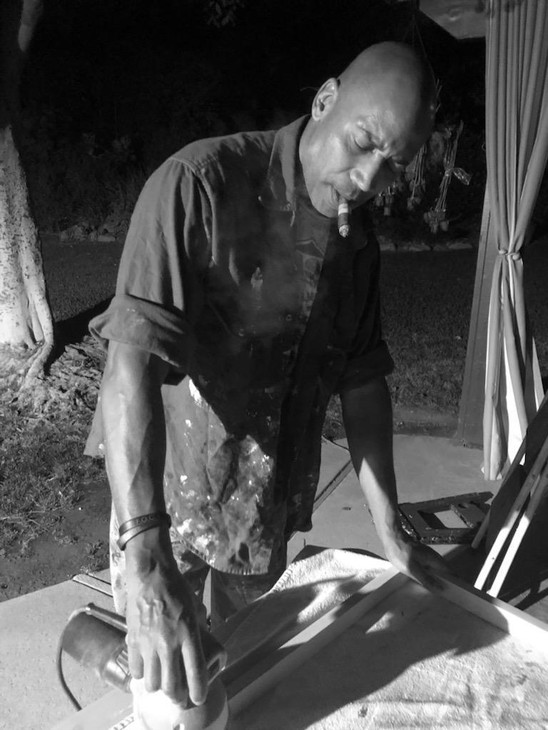
I had the privilege of interviewing Hoodye a little over four years ago, at the unveiling of his series, What I See at the Walt Girdner Gallery in Pasadena, CA. If my first encounter with Hoodye had only been through his artwork, I would have had no idea that he was even involved in law enforcement. That’s a good thing.
Hoodye’s first viewpoint on the world was through the lens of an artist. He said in a recent interview, “Art is the way that I breathe.”
When I spoke with him in 2017, he talked about what appeared to be a culturally rich, and highly creative childhood.
“I literally say I’ve been an artist as long as I have been Black. I’ve always drawn. My mother used to bring home that dot matrix paper. We always age ourselves when we mention that stuff.
“So, I would do murals. I would string them all together. I love underwater stuff, I love the whole Jacque Cousteau, growing up on all that stuff I would do a lot of underwater battle scenes, and it would just be this huge mural of death and destruction, of sharks and divers, and I’ve always done things like that. So, as I’ve gotten older, they really fueled and nurtured the passion, by taking me to museums all the time.”
Hoodye admits he did not take this gift seriously, and it cost him a full-ride scholarship.
“I ended up losing a partial scholarship in art and poetry that he [his teacher] told me about later. And by the way, nobody one else was up for it, he only put me up—I was a shoe-in. One of the things he said was that I wasn’t taking my craft seriously. That really stuck with me, it really resonated. So, I knew at that time I wasn’t ready to pursue that path.”
Hoodye chose law enforcement, which was a field he resonated with early on.
“Law enforcement was something I enjoyed. I was a student worker at the Sheriff’s station in City of Industry, I enjoyed that camaraderie,” he said.
“I’m a passionate person, but I am also a very active person. That resonated. Knowing what I know now, it was the best route for me. Because the idea of having to do what you love to eat—and I’ve seen people have to go through that—you compromise your voice. I’ve never wanted to compromise my voice.”
Having seen the artwork up close and personal, I can attest to this. The voice is powerful and uncompromising, at times whispering, other times screaming, or simply holding you in place, in order for you to take a closer look.
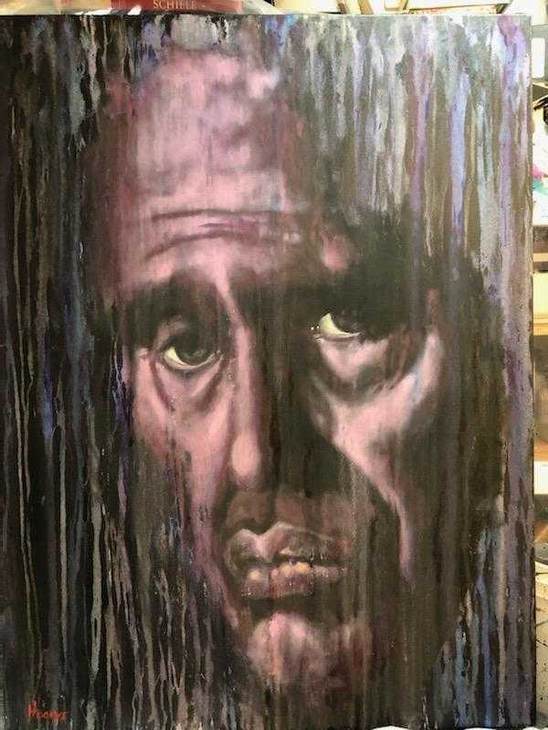
“I’m actually glad that I waited as long as I have. It’s worked out well. My voice isn’t compromised, my craft is getting better all the time. I’m confident, and I feel great about what I am doing as an artist.”
That confidence has not waned, and his voice has only grown stronger and more pronounced and more pivotal in these times. One of his newer pieces, which is actually three pieces in one, is called “America Divided.” It shows the Far Left, and the Far Right, and then there is what lies in the center. It’s a thought-provoking work that allows for the viewer to find that center that brings both sides together.
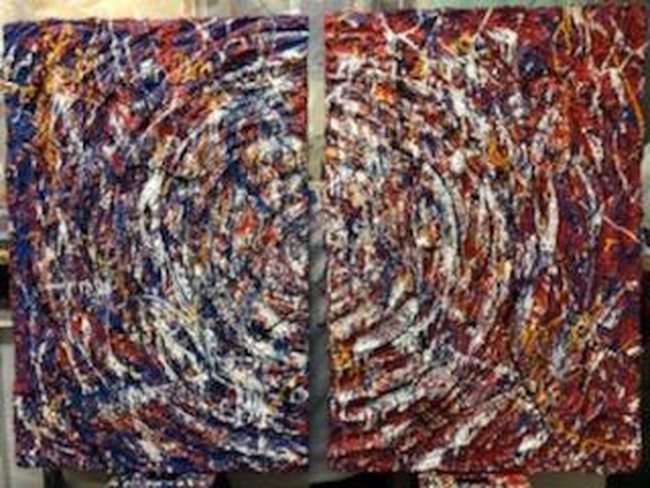
Last week, our mutual friend alerted me to a YouTube interview Sean Hoodye did with with Del Lampkin of Harbinger Horizons, LLC. Hoodye spoke with Lampkin about his latest exhibition in September titled, Vivid: Life As Color. This exhibit unveiled a portrait that is compelling and crucial during this period of stress, struggle, and attack on law enforcement and the work that they do.
Called, “Endangered Species,” Hoodye gives a window on the attacks on law enforcement and cries of, “Defund the Police” through his unique lens of being behind the badge. It is breathtaking not only in its color and composition, but its movement and message. A message which may not be what one would initially assume.
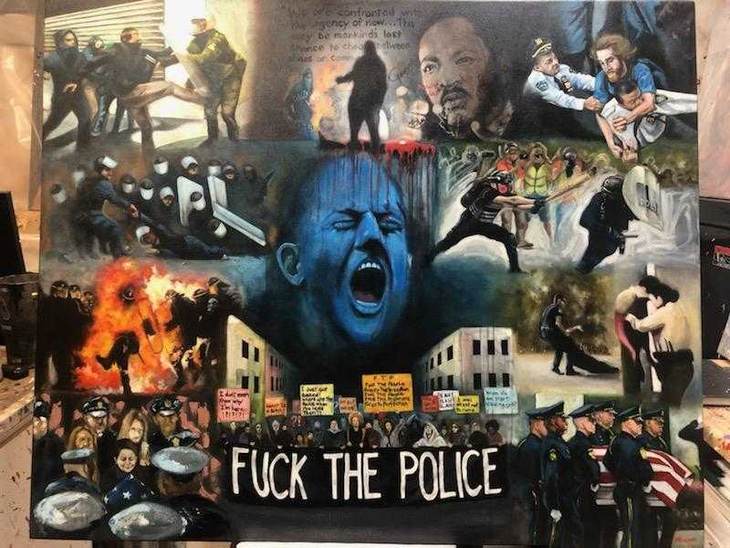
In his conversation with Lampkin, they talked about how “Endangered Species” came about, and Hoodye’s statement and homage to his brothers and sisters in blue, many who he trained and equipped to do the jobs they do.
Lampkin, who also serves in law enforcement, inquired how art in general could help law enforcement officers cope with the ugliness and attacks they encounter.
Hoodye responded:
“We’re seen. There is someone out there who sees you and they see you in a way that brings others in who want to see and be seen.”
Hoodye described himself as a closet poet, and he wrote a poem that speaks to that very theme:
No smiles and no frowns,
You see me so small.
But I see you go to and fro,
The unseen see’s all.
You refuse my glance
And yet you stare.
You may only see a nuisance,
But don’t think me unaware.
I have no issue
With hearing the word “NO”.
But please do me the courtesy
Of looking at me when you do so.
I am only just a man,
I’ll try not to bite.
But that arrogant look of distain
Would make even a priest want to fight.
So give or give not
And I will live on.
Feeling much like you,
Still unseen……an unseen pawn.
By: S. Christopher (used with permission.)
This is the heart of Hoodye’s artwork: whether it is presenting a window on different people and cultures (or subcultures), emphasizing the stark nakedness of our existence, or the duplicity in our personal and political divides. The viewer is allowed entry into another world, another perspective, and confronted, often in-your-face, with the reality of that situation and circumstance.
“The art that I try to make, I try to bring everything in,” Hoodye said to Lampkin.
In my interview, Hoodye put a finer point on the need for all of us to see others, as they are.
“It’s like the homeless, the idea that they are not always seen,” he said.
“We dehumanize them, we don’t look them in the eyes, instead we look around them; they ask for money, we ignore them. If you’re going to do that, at least look them in the eye. That’s fair, and that’s just.
“People just simply want to be seen. They want to be acknowledged. They want to be respected.”
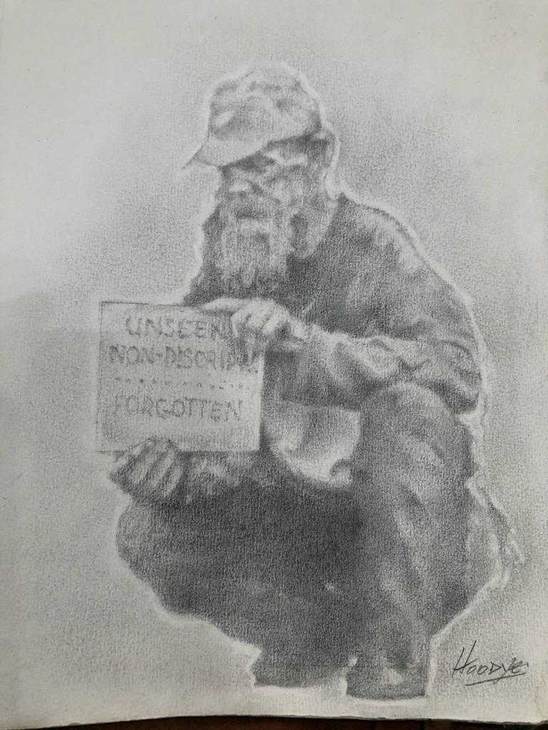
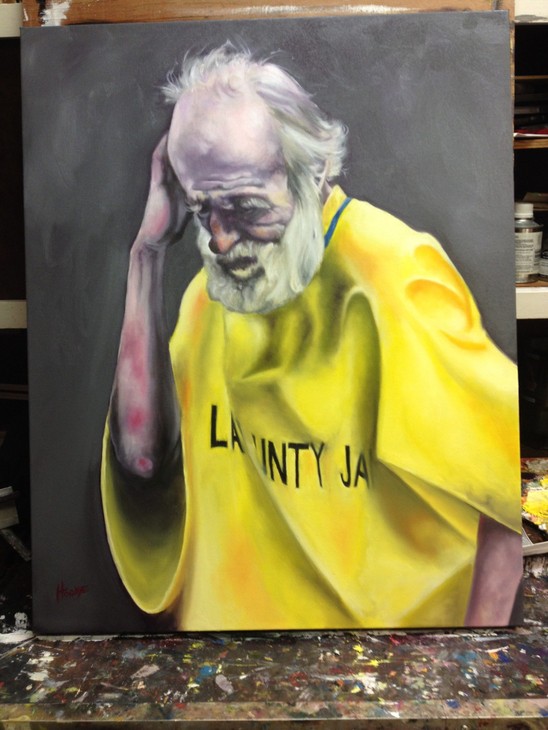
Hoodye told Lampkin that he would not put a price tag on “Endangered Species,” because he did not create it for a private collector or collection—he created it to have an audience—to be seen by many eyes. He told Lampkin that he would like it to be presented in a museum,
“I don’t want this to be seen by cops, because they know.
[..]
“I want that dialogue, I want that conversation.
“I want it to be seen by other people, so they can have those ‘Aha’ moments.”
This desire to create conversations, connection, and common ground among others was present back in 2017 in our interview, and I am thankful this aspect of his artistic voice has deepened and become even more entrenched.
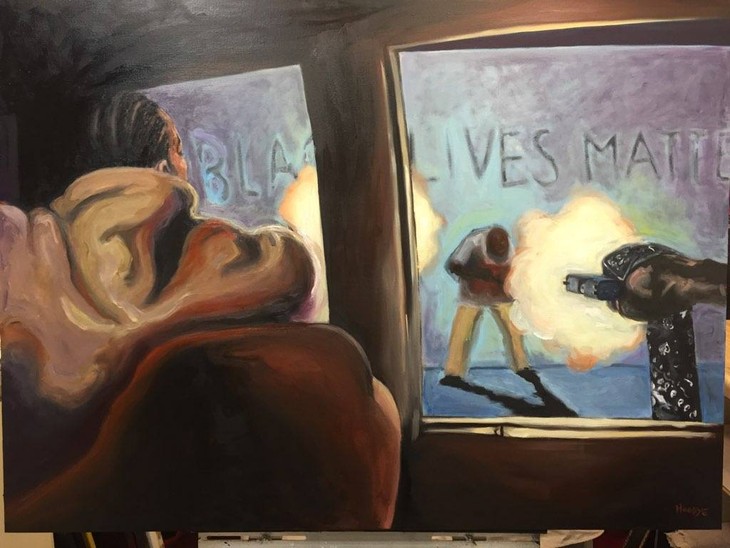
“There is so much art out there that we see that is just fluffy, and it’s nice, and it’s pretty, and it does nothing for the brain. I shouldn’t say that—it is does limited things for the brain, it does nothing for the soul,” he emphasized.
“It doesn’t provoke the kind of thought that makes you want to do something, like help someone else, like do something else, like serve something that is greater than yourself. I believe, I’d like to think that I do that, in the hopes that it will help someone, it will serve a greater master, it will serve something bigger than just me, my pocketbook, my family, my life.”
In honor of Sean Hoodye’s tremendous voice and gifts both behind the badge and in civilian life, I salute him and his work in giving officers tools and voice, both on the street and off.
You can connect with Sean Hoodye and his artwork at his Art By Hoodye website.
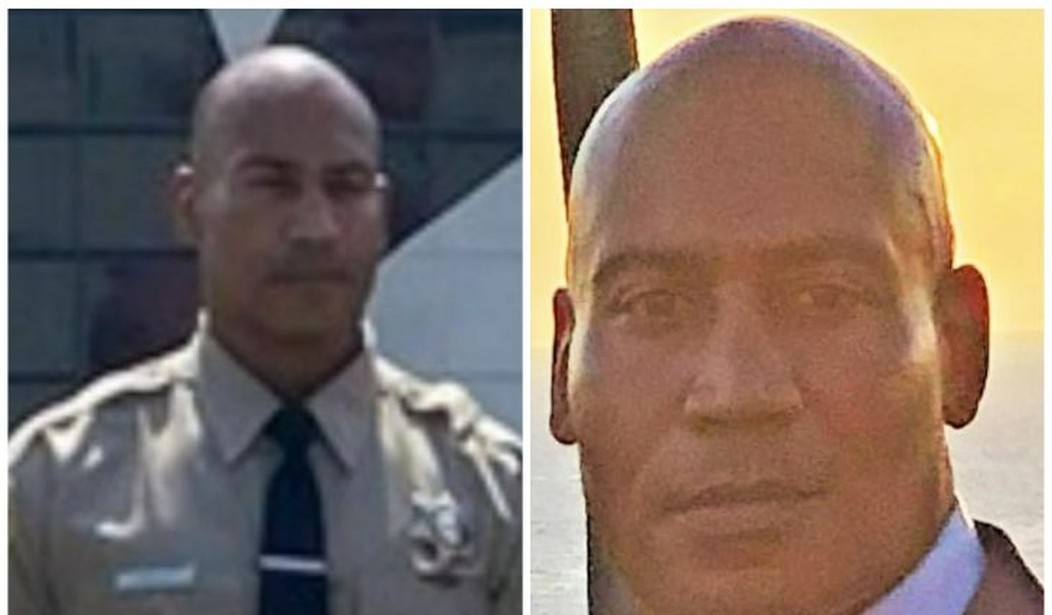
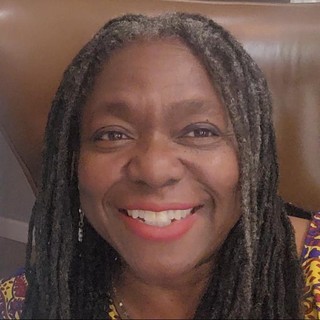



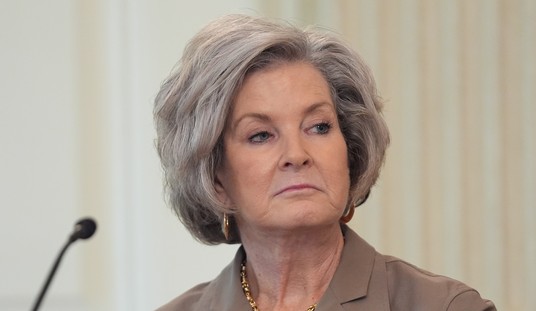






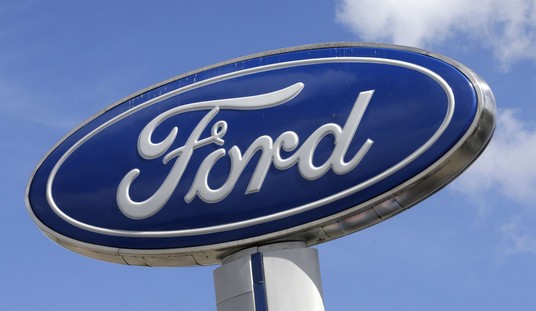


Join the conversation as a VIP Member